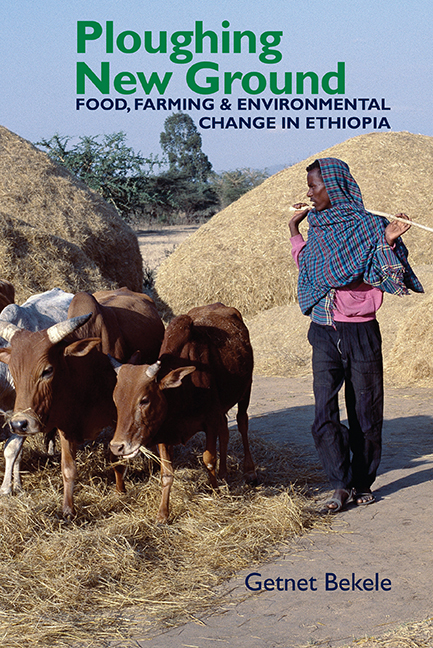Book contents
- Frontmatter
- Dedication
- Contents
- List of Maps and Tables
- Acknowledgements
- Note on Orthography
- Acronyms & Abbreviations
- Glossary
- Map
- Introduction
- 1 Landscape Pastoral: The making and remaking of a grassland environment, 1886–1916
- 2 Negotiating a Landscape: Continuity and change in a grassland environment, 1917–1941
- 3 Blurring the Boundaries: The ascendancy of crop production in a flexible environment, 1942–1955
- 4 Fresh Encounters and Morphing Strategies: The changing organization of production in an era of agricultural intervention, 1956–1965
- 5 Inputs, Outputs and the Farm: Transformations in the science, politics and praxis of agricultural development, 1966–1974
- 6 Competition and Co–existence: Creating space for small- to large-scale farming, 1966-1974
- 7 Of Production and Production Relations: Farming in an era of revolutionary change and socialist development, 1975–1991
- 8 Vicious Circle: Agricultural development at the time of ‘revolutionary democracy’, 1991–2016
- Conclusion
- Bibliography
- Index
- Eastern African Studies
7 - Of Production and Production Relations: Farming in an era of revolutionary change and socialist development, 1975–1991
Published online by Cambridge University Press: 31 August 2018
- Frontmatter
- Dedication
- Contents
- List of Maps and Tables
- Acknowledgements
- Note on Orthography
- Acronyms & Abbreviations
- Glossary
- Map
- Introduction
- 1 Landscape Pastoral: The making and remaking of a grassland environment, 1886–1916
- 2 Negotiating a Landscape: Continuity and change in a grassland environment, 1917–1941
- 3 Blurring the Boundaries: The ascendancy of crop production in a flexible environment, 1942–1955
- 4 Fresh Encounters and Morphing Strategies: The changing organization of production in an era of agricultural intervention, 1956–1965
- 5 Inputs, Outputs and the Farm: Transformations in the science, politics and praxis of agricultural development, 1966–1974
- 6 Competition and Co–existence: Creating space for small- to large-scale farming, 1966-1974
- 7 Of Production and Production Relations: Farming in an era of revolutionary change and socialist development, 1975–1991
- 8 Vicious Circle: Agricultural development at the time of ‘revolutionary democracy’, 1991–2016
- Conclusion
- Bibliography
- Index
- Eastern African Studies
Summary
To the lake region's small-scale farmers, most notably to the share tenants – the majority – the outbreak of the Ethiopian revolution in September 1974 was a welcome development. This was mainly because of the opportunity that the major land-reform edict that the incumbent military administration (the Derg) promulgated in March 1975 gave them to enjoy almost inalienable usufruct right on the cultivated fields already under their control. In addition, the same edict outlawed private ownership of agricultural land and the land market, the organization of individually owned medium- to large-scale farms, and the exaction of agricultural rent altogether. Yet the fact that this edict put all landed properties under ‘public’ or state control meant that now as before the rules and practices governing access to agricultural land had to be constantly debated, acted upon and negotiated. The result was the propagation and retrenchment of small-scale farming across the lake region and most other parts of the country on a hitherto unprecedented scale.
‘LAND TO THE TILLER’ AND THE TILLERS’ RESPONSE
It took the Derg only six months to promulgate a major land-reform edict in Ethiopia in March 1975. When promulgating that edict, the military administration was responding proactively to the notion of ‘land to the tiller’ that the student harbingers of the revolution had embraced since the mid-1960s. Interestingly, some of these former students and their closest supporters were among those that had been active in drafting that edict a decade later. If dismantling what the students had referred to as the social, economic and political foundations of the ancient regime was one of the reasons that made ‘land to the tiller’ their movement's rallying cry in the first place, that was also what the land-reform edict was able to accomplish on their behalf when it became law that year.
Called and mobilized by the Derg under the banner of the National Development through Cooperation Campaign, better known by its Amharic term zamacha, the same group of college students and their high school counterparts were among those that directly partook in the edict's implementation in rural Ethiopia in the following year.
- Type
- Chapter
- Information
- Ploughing New GroundFood, Farming & Environmental Change in Ethiopia, pp. 141 - 158Publisher: Boydell & BrewerPrint publication year: 2017

